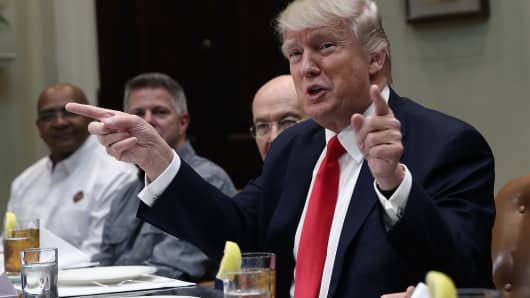To hear President Donald Trump tell it, you'd think the U.S. job market was in the worst shape since the Great Depression.
In fact, a broad review of the available economic data shows that the overall health of U.S.employment is better than it's been in decades. The supporting evidence goes far beyond the single unemployment rate reported Friday that draws the most attention every month.
The latest report from the Bureau of Labor Statistics — the decades-old survey that Trump took issue with during the campaign — showed that the U.S. economy produced an estimated 227,000 net new jobs last month, while the unemployment rate ticked up to 4.8 percent.
On the campaign trail, Trump dismissed officials numbers like those as a "hoax."
"Don't believe these phony (employment) numbers," Trump has told his supporters. "The number is probably 28, 29, as high as 35 (percent). In fact, I even heard recently 42 percent."
After the jobs report, Trump said Friday before a meeting with top CEOs that he was happy with the 227,000 jobs and praised the "spirit in the country right now."
"I think it's going to continue big league," he added.
To be sure, the government's most widely watched employment report (officially the Employment Situation Summary) includes multiple measures of unemployment, six in all, to provide businesses and policymakers a more accurate picture of longer-term trends.
According to the broadest measure (U-6), which includes so-called discouraged workers, the jobless rate is much higher — 9.4 percent as of last month. That measure has been much higher than the so-called headline rate since the government began the current six-tier data set in 1995.
By contrast, the narrowest jobless measure doesn't count someone as "unemployed" until they've been out of work for more than 15 weeks. That measure (U-1) was 1.9 percent in January.
Despite the variance in the different measures, these jobless rates have fallen close to levels not seen since the last days of the go-go '90s internet boom.
Even last month's one-tenth of a percent rise in the jobless rate was, in some ways, another sign of improvement. The increase came because the labor force participation rate — the share of the population working or looking for a job — rose by two-tenths of a percent as more than half a million people entered the workforce.
At least some of those were people who had given up looking for a job, but are now resuming a job hunt because their prospects have improved.
The job market momentum of the last few years is also pushing wages higher, after a long, painful pause for American households. Those meager gains in workers' paychecks for the last decade were a major theme of last year's campaign.
Now, the continued demand for workers to fill new positions is finally pushing wages higher, according to Jim O'Sullivan, chief U.S. economist at High Frequency Economics.
"The trend in employment growth remains more than strong enough to keep the unemployment rate trending down and adding to upward pressure on wage gains," he said.
Beyond the monthly unemployment rate data there are other job market statistics that are hard to square with Trump's dystopian take on the prospects for American workers.
For example, the pace of weekly unemployment claims, a benchmark for the rate of layoffs, is at the lowest level since the 1973 oil embargo.
A separate, less well-known measure of hiring, the Job Openings and Labor Turnover Survey (JOLTS), offers further evidence of that the economy is creating new jobs at a healthy clip.
While the more widely watched monthly employment report tracks the net gain or loss in payrolls, there are many more jobs created and lost each month. So the 227,000 new jobs reported for January are the difference between everyone who was hired last month and everyone who quit or was laid off.
The JOLTS survey tracks that broader churn in employment along with the number of job openings. And the latest survey shows that there are more than 5 million unfilled positions. That's the highest at any time at least since 2000, when the survey began.



